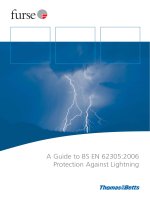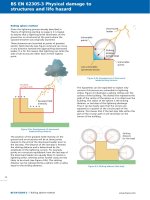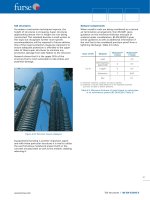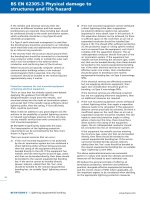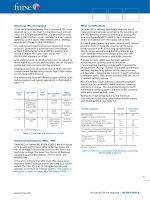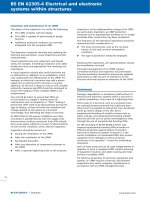Bsi bs en 00597 1 2015
Bạn đang xem bản rút gọn của tài liệu. Xem và tải ngay bản đầy đủ của tài liệu tại đây (978.39 KB, 16 trang )
BS EN 597-1:2015
BSI Standards Publication
Furniture — Assessment of the
ignitability of mattresses and
upholstered bed bases
Part 1: Ignition source smouldering
cigarette
BS EN 597-1:2015
BRITISH STANDARD
National foreword
This British Standard is the UK implementation of EN 597-1:2015. It
supersedes BS EN 597-1:1995 which is withdrawn.
The UK participation in its preparation was entrusted to Technical
Committee FW/6, Flammability performance and fire tests for
furniture.
A list of organizations represented on this committee can be
obtained on request to its secretary.
This publication does not purport to include all the necessary
provisions of a contract. Users are responsible for its correct
application.
© The British Standards Institution 2016.
Published by BSI Standards Limited 2016
ISBN 978 0 580 85287 9
ICS 13.220.40; 97.140
Compliance with a British Standard cannot confer immunity from
legal obligations.
This British Standard was published under the authority of the
Standards Policy and Strategy Committee on 31 January 2016.
Amendments/corrigenda issued since publication
Date
Text affected
BS EN 597-1:2015
EN 597-1
EUROPEAN STANDARD
NORME EUROPÉENNE
EUROPÄISCHE NORM
December 2015
ICS 13.220.40; 97.140
Supersedes EN 597-1:1994
English Version
Furniture - Assessment of the ignitability of mattresses
and upholstered bed bases - Part 1: Ignition source
smouldering cigarette
Ameublement - Évaluation de l'allumabilité des
matelas et des sommiers rembourrés - Partie 1 : Source
d'allumage : cigarette en combustion
Möbel - Bewertung der Entzündbarkeit von Matratzen
und gepolsterten Bettböden - Teil 1: Zündquelle:
glimmende Zigarette
This European Standard was approved by CEN on 7 November 2015.
CEN members are bound to comply with the CEN/CENELEC Internal Regulations which stipulate the conditions for giving this
European Standard the status of a national standard without any alteration. Up-to-date lists and bibliographical references
concerning such national standards may be obtained on application to the CEN-CENELEC Management Centre or to any CEN
member.
This European Standard exists in three official versions (English, French, German). A version in any other language made by
translation under the responsibility of a CEN member into its own language and notified to the CEN-CENELEC Management
Centre has the same status as the official versions.
CEN members are the national standards bodies of Austria, Belgium, Bulgaria, Croatia, Cyprus, Czech Republic, Denmark, Estonia,
Finland, Former Yugoslav Republic of Macedonia, France, Germany, Greece, Hungary, Iceland, Ireland, Italy, Latvia, Lithuania,
Luxembourg, Malta, Netherlands, Norway, Poland, Portugal, Romania, Slovakia, Slovenia, Spain, Sweden, Switzerland, Turkey and
United Kingdom.
EUROPEAN COMMITTEE FOR STANDARDIZATION
COMITÉ EUROPÉEN DE NORMALISATION
EUROPÄISCHES KOMITEE FÜR NORMUNG
CEN-CENELEC Management Centre: Avenue Marnix 17, B-1000 Brussels
© 2015 CEN
All rights of exploitation in any form and by any means reserved
worldwide for CEN national Members.
Ref. No. EN 597-1:2015 E
BS EN 597-1:2015
EN 597-1:2015 (E)
Contents
Page
European foreword....................................................................................................................................................... 3
Introduction .................................................................................................................................................................... 4
1
Scope .................................................................................................................................................................... 5
2
Terms and definitions ................................................................................................................................... 5
3
3.1
3.2
Criteria of ignition........................................................................................................................................... 6
Progressive smouldering ignition............................................................................................................. 6
Flaming ignition............................................................................................................................................... 6
4
Principle ............................................................................................................................................................. 6
5
5.1
5.2
5.3
Health and safety of operators ................................................................................................................... 6
General ................................................................................................................................................................ 6
Enclosure............................................................................................................................................................ 6
Extinguishers .................................................................................................................................................... 6
6
6.1
6.2
6.3
6.4
Apparatus........................................................................................................................................................... 7
Test rig ................................................................................................................................................................ 7
Test enclosure .................................................................................................................................................. 8
Clock..................................................................................................................................................................... 8
Ignition source smouldering cigarette .................................................................................................... 8
7
7.1
7.2
Atmospheres for conditioning and testing ............................................................................................ 8
Conditioning...................................................................................................................................................... 8
Atmosphere for testing ................................................................................................................................. 8
8
8.1
8.2
8.3
Test specimen ................................................................................................................................................... 8
General ................................................................................................................................................................ 8
Small scale ......................................................................................................................................................... 9
Full size ............................................................................................................................................................... 9
9
9.1
9.2
9.3
Test procedure ................................................................................................................................................. 9
Preparation ....................................................................................................................................................... 9
Ignition source application.......................................................................................................................... 9
Final examination ........................................................................................................................................ 10
10
Test report ...................................................................................................................................................... 10
Annex A (informative) Model test report form................................................................................................. 11
2
BS EN 597-1:2015
EN 597-1:2015 (E)
European foreword
This document (EN 597-1:2015) has been prepared by Technical Committee CEN/TC 207 “Furniture”,
the secretariat of which is held by UNI.
This European Standard shall be given the status of a national standard, either by publication of an
identical text or by endorsement, at the latest by June 2016 and conflicting national standards shall be
withdrawn at the latest by June 2016.
Attention is drawn to the possibility that some of the elements of this document may be the subject of
patent rights. CEN [and/or CENELEC] shall not be held responsible for identifying any or all such patent
rights.
This document supersedes EN 597-1:1994.
The test is based on EN 1021-1, Furniture – Assessment of the ignitability of upholstered furniture – Part
1: Ignition source: smouldering cigarette.
The main changes in relation to EN 597-1:1994 are:
— modification to the specification of the weight of the ignition source;
— modification to the test procedure to allow a third ignition source to be placed on the test sample if
either of the two initial ignition sources self extinguish prior to the completion of the test.
According to the CEN-CENELEC Internal Regulations, the national standards organizations of the
following countries are bound to implement this European Standard: Austria, Belgium, Bulgaria,
Croatia, Cyprus, Czech Republic, Denmark, Estonia, Finland, Former Yugoslav Republic of Macedonia,
France, Germany, Greece, Hungary, Iceland, Ireland, Italy, Latvia, Lithuania, Luxembourg, Malta,
Netherlands, Norway, Poland, Portugal, Romania, Slovakia, Slovenia, Spain, Sweden, Switzerland,
Turkey and the United Kingdom.
3
BS EN 597-1:2015
EN 597-1:2015 (E)
Introduction
This European Standard is one of a series of standards concerned with the ignitability of mattresses and
upholstered bed bases using different ignition sources. The ignition source used in this European
Standard is a smouldering cigarette.
When mattresses or bed bases are used or stored on their own, it is desirable to know their ignitability
in their own right.
It cannot be assumed that protection against flaming sources will automatically give protection against
smouldering ignition. Users of the standard should therefore recognize the need to submit test
specimens to both cigarette and flaming ignition tests.
WARNING — Attention is drawn to the fact that the tests given in the test report (see Clause 10)
are not intended to reproduce the full fire hazards that may be encountered.
4
BS EN 597-1:2015
EN 597-1:2015 (E)
1 Scope
This European Standard specifies a test method to assess the ignitability of mattresses, upholstered bed
bases or mattress pads when subjected to a smouldering cigarette as an ignition source.
Air mattresses and water beds are excluded from this standard.
The standard contains one annex:
Annex A (informative) Model test report form.
2 Terms and definitions
For the purposes of this document, the following terms and definitions apply.
2.1
progressive smouldering
exothermic oxidation, not accompanied by flaming, that is self-propagating, i.e. independent of the
ignition source, which may or may not be accompanied by incandescence
2.2
flaming
undergoing combustion in the gaseous phase with the emission of light
2.3
flammability
ability of a material or product to burn with a flame under the specified test conditions
2.4
ignitability
measure of the ease with which a material, product or component can be ignited so as to flame or
progressively smoulder
2.5
ignition source
source of energy used to ignite combustible materials or products
2.6
mattress pad
upholstered product that is used in conjunction with, and to complement, a mattress or upholstered bed
base
2.7
mattress
upholstered product intended for sleeping upon
2.8
bed base
structure that supports a mattress or the surface(s) of a mattress that support(s) a user
2.9
upper surface
surface of a bed base that supports a mattress or the surface(s) of a mattress that support(s) a user
5
BS EN 597-1:2015
EN 597-1:2015 (E)
3 Criteria of ignition
3.1 Progressive smouldering ignition
For the purposes of this European Standard, all the following types of behaviour are considered to be
progressive smouldering ignitions:
a) any test assembly that displays escalating combustion behaviour so that it is unsafe to continue the
test and active extinction is necessary;
b) any test assembly that smoulders until it is largely consumed within the test duration;
c) any test assembly that smoulders to its full thickness, within the duration of the test;
d) any test assembly that smoulders after one hour from the application of the ignition source;
e) any test assembly that, on final examination (see 9.3), shows evidence of progressive smouldering.
NOTE
In practice it has been found that there is usually a clear distinction between materials which can char
under the influence of the ignition source but which do not propagate further (non-progressive combustion) and
those where smouldering develops in extent and spreads (progressive combustion).
3.2 Flaming ignition
For the purposes of this European Standard, a flaming ignition is considered to be the occurrence of any
flames initiated by a smouldering source.
4 Principle
To subject a full upper surface or upper surface characteristic features of a mattress, the bed base or the
mattress pad to the contact of a smouldering ignition source by using smouldering cigarettes so that all
the zones having different characteristics are tested.
5 Health and safety of operators
5.1 General
The test method specified in this European Standard presents a considerable hazard; suitable
precautions shall be taken, which may include the provision of breathing apparatus and protective
clothing.
5.2 Enclosure
For safety, the test should be conducted in a non-combustible fume cupboard. If such a cupboard is not
available, a test enclosure should be constructed (see 6.2) so that the operator is protected from the
fumes.
5.3 Extinguishers
Adequate means of extinguishing the assembly should be provided bearing in mind that some
combinations may produce severe flaming during the test. A hand and/or fixed water spray which can
be directed over the burning area can be useful. Other means such as suitable fire extinguishers, fire
blankets and a bucket of water will assist.
In some cases smouldering may be difficult to extinguish completely and complete immersion in water
may be necessary.
6
BS EN 597-1:2015
EN 597-1:2015 (E)
6 Apparatus
6.1 Test rig
Consisting of a platform of expanded steel or open mesh at least 450 mm x 450 mm supported at least
75 mm above a solid base (a suitable test rig mesh is illustrated in Figure 1). The size of the mesh is not
critical.
For the tests, the rigs shall be sited within the enclosure (see 6.2) and the testing shall be performed in a
basically draught-free environment permitting an adequate supply of air and removal of smoke from
the area of the apparatus.
Dimensions in millimetres
Key
A mesh made from wire approximately 2 mm in diameter
X test rig width at least test specimen width
Y test rig length at least test specimen length
Figure 1 — Test rig assembly
7
BS EN 597-1:2015
EN 597-1:2015 (E)
6.2 Test enclosure
The test enclosure shall consist of either a room with a volume greater than 20 m3 (which contains
adequate oxygen for testing) or a smaller enclosure with a through flow of air. Inlet and extraction
systems providing an air speed rate of less than 0,2 m/s in the locality of the rig provide adequate
oxygen without disturbing the burning behaviour.
6.3 Clock
The clock shall be capable of measuring to at least 1 h with an accuracy of 1 s.
6.4 Ignition source smouldering cigarette
An un-tipped cylindrical cigarette complying with the following requirements shall be used:
—
length:
(68 ± 2) mm;
—
mass:
(0,85 ± 0,15) g.
—
diameter:
(8 ± 0,5) mm;
The smouldering rate shall be (7,5 ± 2) min/40 mm, when tested as follows.
Mark the cigarette, conditioned as described in 7.1 at 10 mm and 50 mm from the end to be lit. Light it
as described in 9.2.1 and impale it horizontally in air (air speed rate less than 0,2 m/s) on a horizontal
wire spike inserted not more than 13 mm into the unlit end.
Record the time taken to smoulder from the 10 mm to the 50 mm mark.
The smouldering rate shall be measured on one cigarette from a batch of 20 cigarettes. The smouldering
rate may be measured on two cigarettes at the same time. The distance between cigarettes and between
each cigarette and any nearby surface such as the wall or floor of the test enclosure shall be at least
150 mm.
If the cigarette ceases smouldering before reaching the 50 mm mark, the measurement of smouldering
rate shall be repeated.
7 Atmospheres for conditioning and testing
7.1 Conditioning
The materials to be tested and the cigarettes shall be conditioned for at least 24 h immediately before
the tests in the following atmosphere:
—
—
temperature:
relative humidity:
(23 ± 2) °C;
(50 ± 5) %.
7.2 Atmosphere for testing
The test shall be carried out in an atmosphere having a temperature between 10 °C and 30 °C and a
relative humidity between 15 % and 80 %.
8 Test specimen
8.1 General
The test assembly materials shall be representative of the components and make-up of the finished
mattress, mattress pad or upholstered bed base.
8
BS EN 597-1:2015
EN 597-1:2015 (E)
8.2 Small scale
For small scale tests, the test specimen shall be rectangular in shape and have a minimum size of
450 mm x 450 mm x nominal thickness of the finished mattress, mattress pad or upholstered bed base.
The type of proposed edge finishing system shall be incorporated, e.g. plain, piped or taped edge.
Representative tension shall be maintained in the cover. The proposed mattress, mattress pad or
upholstered bed base finish shall be represented in the specimen, e.g. tufted or quilted.
NOTE
Representative tension can be maintained in the cover by means of suitable clips if the section is
produced by cutting.
8.3 Full size
For full size tests 1:1, the actual product shall form the test specimen.
9 Test procedure
9.1 Preparation
NOTE
The application of the ignition source can be within 20 min of removing the test materials from the
conditioning atmosphere (7.1). If there is a significant distance between the conditioning room and the room
where testing is carried out, the materials can be protected against de-conditioning during transfer between
rooms. If possible, the assembly can be prepared inside the conditioning room.
9.1.1
9.1.2
Ensure that means of extinguishing are close to hand (see 5.3).
For a small scale test, place the test specimen in the test rig (see 6.1).
For full size tests:
— bed bases are tested on a horizontal surface (feet of the bed bases may have to be fitted if they exist
on the actual product;
— mattresses or mattress pads are tested on a horizontal surface.
9.2 Ignition source application
9.2.1 Within 20 min of removing the materials from the conditioning atmosphere, light two cigarettes
and draw air through it until the tip glows brightly. Not less than 5 mm and not more than 8 mm of the
cigarette shall be consumed in this operation.
9.2.2 Position the smouldering cigarettes in position on a flat portion of the upper surface of the test
specimen so that the cigarette is not less than 50 mm from the nearest edge or marks left by any
previous tests, and simultaneously start the clock. Where the test specimen has a piped or taped-edge
finish, or is quilted or tufted, position two cigarettes on each feature such as on the taped edge, in the
groove of the quilt-line and on the tufts.
9.2.3 Observe the progress of combustion and record any evidence of progressive smouldering
ignition (see 3.1 a), b), c) or d)) or flaming ignition (see 3.2) of the test specimen.
NOTE
The detection of smouldering can be difficult and is eased by watching for smoke emerging at points at
a distance from the cigarette. Smoke is most easily viewed by looking down a rising column by means of a mirror.
9.2.4 If progressive smouldering ignition or flaming ignition of the test specimen is observed,
extinguish the test specimen and record this, together with the time elapsed between placing and
extinguishing. In these circumstances discontinue testing and complete the test report (see Clause 10).
9
BS EN 597-1:2015
EN 597-1:2015 (E)
If progressive smouldering ignition or flaming ignition of the test specimen is not observed and the
cigarette smoulders its complete length, record this and carry out the final examination (see 9.3).
If one of the cigarettes fail to smoulder its complete length, record this and repeat the test with a new
cigarette placed in a fresh position not less than 50 mm from any previous test damage.
If the progressive smouldering ignition or flaming ignition of the test specimen is observed in this
repeat test, extinguish the test specimen and record this, together with the time elapsed between
placing and extinguishing. In these circumstances discontinue testing and complete the test report (see
Clause 10).
If progressive smouldering ignition or flaming ignition of the test specimen is not observed in this
repeat, or if the cigarette fails to smoulder its complete length, record this and carry out the final
examination (see 9.3).
9.2.5 For small scale tests (see 8.1), it may be impossible to complete the number of tests required on
one specimen. If so, use identical specimens to complete the full number of tests.
9.2.6
If the two surfaces of the test specimen are different in any way, both sides shall be tested.
9.3 Final examination
Cases of progressive smouldering ignition undetected from the outside have been reported.
Immediately after completion of the test programme, dismantle the test specimen and examine it
internally for progressive smouldering ignition. If this is found, extinguish the test specimen, and record
that smouldering ignition has occurred and complete the test report (see Clause 10). For safety reasons
ensure that all smouldering has ceased before the rig is left unattended.
If no internal progressive smouldering ignition is found, record non-ignition and complete the test
report (see Clause 10).
10 Test report
The test report, of which the form shown in Annex A is an example, shall give the following information:
a) reference to this European Standard, i.e. EN 597-1;
b) description of the mattress, mattress pad or upholstered bed base and any other components, and if
necessary, the identification of the tested surface;
c) whether ignition or non-ignition occurred in each test. If ignition occurred with at least one of the
cigarette applications, the overall result is taken as ignition;
d) if ignition occurred, whether it was progressive smouldering ignition or flaming ignition, and the
measurements or observations relevant to the criteria for ignition;
e) if self-extinguishing of the cigarettes occurred.
The report shall also include the words “The above test results relate only to the ignitability of the
combination of materials under the particular conditions of test; they are not intended as a means of
assessing the full potential fire hazard of the mattress, mattress pad or upholstered bed base in use.”
10
BS EN 597-1:2015
EN 597-1:2015 (E)
Annex A
(informative)
Model test report form
Issuing authority .................................................................................................................................. Test No. ..............................................
Sample…………………………………………………………. Date …………….
Company ……………………..
Test report in accordance with EN 597-1 (confidential)
Assessment of ignitability: Ignition source: smouldering cigarette
Materials tested: .....................................................................................................................................................................................................
Surface tested: .........................................................................................................................................................................................................
Test results: (non-ignition, smouldering ignition, flaming ignition): ............................................................................................
Criteria of ignition
Cigarette
1
Smouldering criteria.................................................................... *
2
*
Comments (including
position of the failing
cigarette)
3
*
Unsafe escalating combustion (3.1 a)
Test assembly consumed (3.1 b)
Smoulders through thickness (3.1 c)
Smoulders more than 1 h (3.1 d)
In final examination, presence of progressive
smouldering (3.1 e)
Flaming criteria
Occurrence of flames (3.2)
*Enter ‘YES’ if criteria exceeded or ‘NO’ if
criteria not exceeded
Signed: ........................................................................................................................................................................................................................
(Any extraordinary events should be reported overleaf)
The above test results relate only to the ignitability of the combination of materials under the particular
conditions of test; they are not intended as a means of assessing the full potential fire hazard of the
materials in use.
11
This page deliberately left blank
This page deliberately left blank
NO COPYING WITHOUT BSI PERMISSION EXCEPT AS PERMITTED BY COPYRIGHT LAW
British Standards Institution (BSI)
BSI is the national body responsible for preparing British Standards and other
standards-related publications, information and services.
BSI is incorporated by Royal Charter. British Standards and other standardization
products are published by BSI Standards Limited.
About us
Revisions
We bring together business, industry, government, consumers, innovators
and others to shape their combined experience and expertise into standards
-based solutions.
Our British Standards and other publications are updated by amendment or revision.
The knowledge embodied in our standards has been carefully assembled in
a dependable format and refined through our open consultation process.
Organizations of all sizes and across all sectors choose standards to help
them achieve their goals.
Information on standards
We can provide you with the knowledge that your organization needs
to succeed. Find out more about British Standards by visiting our website at
bsigroup.com/standards or contacting our Customer Services team or
Knowledge Centre.
Buying standards
You can buy and download PDF versions of BSI publications, including British
and adopted European and international standards, through our website at
bsigroup.com/shop, where hard copies can also be purchased.
If you need international and foreign standards from other Standards Development
Organizations, hard copies can be ordered from our Customer Services team.
Subscriptions
Our range of subscription services are designed to make using standards
easier for you. For further information on our subscription products go to
bsigroup.com/subscriptions.
With British Standards Online (BSOL) you’ll have instant access to over 55,000
British and adopted European and international standards from your desktop.
It’s available 24/7 and is refreshed daily so you’ll always be up to date.
You can keep in touch with standards developments and receive substantial
discounts on the purchase price of standards, both in single copy and subscription
format, by becoming a BSI Subscribing Member.
PLUS is an updating service exclusive to BSI Subscribing Members. You will
automatically receive the latest hard copy of your standards when they’re
revised or replaced.
To find out more about becoming a BSI Subscribing Member and the benefits
of membership, please visit bsigroup.com/shop.
With a Multi-User Network Licence (MUNL) you are able to host standards
publications on your intranet. Licences can cover as few or as many users as you
wish. With updates supplied as soon as they’re available, you can be sure your
documentation is current. For further information, email
BSI Group Headquarters
389 Chiswick High Road London W4 4AL UK
We continually improve the quality of our products and services to benefit your
business. If you find an inaccuracy or ambiguity within a British Standard or other
BSI publication please inform the Knowledge Centre.
Copyright
All the data, software and documentation set out in all British Standards and
other BSI publications are the property of and copyrighted by BSI, or some person
or entity that owns copyright in the information used (such as the international
standardization bodies) and has formally licensed such information to BSI for
commercial publication and use. Except as permitted under the Copyright, Designs
and Patents Act 1988 no extract may be reproduced, stored in a retrieval system
or transmitted in any form or by any means – electronic, photocopying, recording
or otherwise – without prior written permission from BSI. Details and advice can
be obtained from the Copyright & Licensing Department.
Useful Contacts:
Customer Services
Tel: +44 845 086 9001
Email (orders):
Email (enquiries):
Subscriptions
Tel: +44 845 086 9001
Email:
Knowledge Centre
Tel: +44 20 8996 7004
Email:
Copyright & Licensing
Tel: +44 20 8996 7070
Email:

